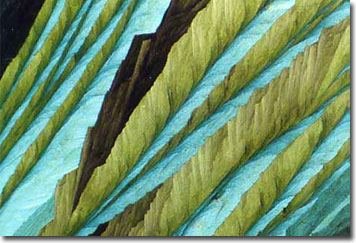Loes Modderman
Thiocarbamide
Thiocarbamide resembles urea in structure, but substitutes sulfur for the oxygen atom that is doubly bonded to the central carbon atom. Better known as thiourea, thiocarbamide is classified as a hazardous chemical that may explode when exposed to fire, releasing toxic nitrogen and sulfur oxides upon heating. Other dangerous properties include efficacy as a skin and respiratory irritant, and the organic chemical is harmful or fatal if ingested.

In stark contrast, thiocarbamide compounds are used as antithyroid drugs and to induce a state of euphoria before thyroid surgery, taking advantage of an ability to be well absorbed and to concentrate in the thyroid. In the thyroid, thiourea inhibits thyroid peroxidase, resulting in lowered thyroid hormone production, but increased proliferation due to an increase in the secretion of thyroid-stimulating hormone. In studies with bacteria, yeast, and insects, heightened rates of gene mutation and chromosomal recombination were detected.
As a chemical reagent, thiocarbamide is used in photographic processing to produce blue tones on print paper and gold tones in sepia prints, but for deeper blues, potassium thiocyanate is substituted. The choice of paper, the amount of bleaching, and the proportion of thiocarbamide placed in the bath determine the color produced by this variable sepia toner, ranging from a yellow hue to chocolate brown. In its crystalline form, thiocarbamide is lustrous and white and is also employed in photocopiers as toner and in industrial organic chemical syntheses such as the production of thiourea-formaldehyde resins used in the fabrication of composite materials. Thiocarbamide is also useful as a catalyst, a rubber accelerator, and in metal processing and plating. Similar to the effects of selenium and gold, thiocarbamide also enhances the permanence of a photographic print, which is most important for archival photographs. Usually, thiocarbamide is used with sodium hydroxide and a yellowish-brown tone is achieved in the photographic print without the objectionable odor typical of the alternative chemical, sodium sulfide. However, thiourea appears to be more sinister as a suspected carcinogen, respiratory irritant, and a threat to a healthy bone marrow. The liver and thyroid glands are also a target for this dangerous chemical that requires a well-ventilated room and should be disposed of in an environmentally-sound and legal fashion as hazardous waste. Although soluble in cold water and alcohol, thiourea is nearly insoluble in ether.
BACK TO LOES MODDERMAN GALLERY
